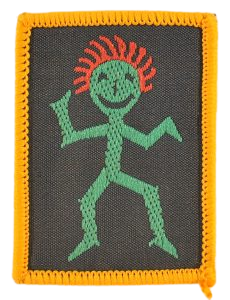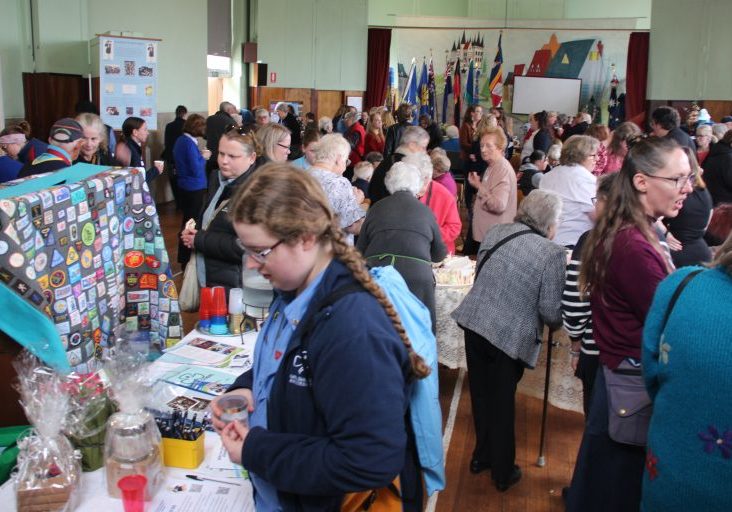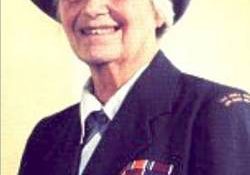Where have the Brownies gone?
 The Brownies are still here, just not the term Brownies.
The Brownies are still here, just not the term Brownies.
All members of Guiding in Australia are known as Guides.
This name change was made in 1996, along with the introduction of a national uniform and a new Guiding Program. No more brown or blue pinafores.
Historically, Brownies referred to the 7-10 year old age group within Guiding. This was the name given to them by Baden-Powell, based on characters from the story "The Brownies" by Juliana Horatia Ewing.
Local Guide, Kaitlyn Brown from the 1st Sebastopol Guide unit worked on the syllabus for the Queens Guide Award. For the Traditions clause, she researched information about Australian Brownie Guides using old handbooks and reference books, as well as the internet. The information was presented in a printed format but has been reproduced here to share the information about the origins of our youngest Guiding section.
Kaitlyn also spent time with the Delacombe Junior Guides (previously known as Delacombe Brownies), running activities to teach the Guides about Brownies.
Brownies
When a new section for 7-10 year-olds was introduced, Lord Baden-Powell originally named them ‘Rosebuds’. However, the girls did not like this name and requested another. Baden-Powell thought about all the fun the Rosebuds were having, and all the hard work they were doing. This made him remember a story he had once heard. The story made B-P sure that ‘Brownies’ was the appropriate name for these girls.
Brownie Traditions
- Toadstools - Brownie units skipped around toadstools in their opening ceremonies, because they believed that fairies used to dance around mushrooms.
- Brown Owl - This was the name used by many leaders of Brownie Guides, named after the wise owl in the Brownie story.
- Pack Pool - Some units used a mirror to represent the pond in the Brownie story as part of the enrolment ceremony.
- Brownie Revels - A gathering of Brownies from different packs, joining together in an activity.
- Brownie Guide Ring - The opening ceremony for each Brownie meeting.
- Brownie Bells - The closing ceremony where a prayer was sung.
- A Special Quiet Sign - Brownie leaders would place their hands on their heads, and the Brownies would do the same.
- Brownie Handshake - Brownies use the left hand when they shake hands with other Guides, Brownies, Scouts, and Cubs.
- Brownie Stars - Each Brownie received a numbered Brownie Star badge on their ‘Brownie Birthday’ (they obtained a new star every year after they were enrolled as a Brownie).
Motto: Lend a hand
The idea was that Brownies would keep their eyes open and try to help whenever they were needed. The secret part of the Brownie Guide Ring was to skip around a circle, singing “lah lah lah lah lah lah”. A common challenge was for the girls to trace around their hand and then perform tasks to help various people. They then wrote their task on each finger.
Brownie Guide Ring
This was the opening ceremony of the Brownie meeting and included the Brownie Guide song. The Brownie Guide Ring was used for enrolments, badge presentations and pow-wows.
Pack Ventures
Ventures were projects the unit did together to help other people. All the Brownies contributed in their own way. Units were encouraged to be a “Willing Worker” (WW).
Uniform
The uniform varied slightly between different Australian states because of weather conditions.
The uniform included:
- A brown dress - long or short sleeve
- Yellow tie, held together with Promise badge
- Brown beret or hat
- Brown shoes
- White or beige socks
- Brown hair ribbons
- Brown cardigan
- Brown belt
This later changed to a brown pinafore and yellow polo shirt.
Compare Brownie Guides to our current Guides
Promise (1968)
I promise that I will do my best:
- to do my duty to God
- to serve the Queen and help other people
- and to keep the Brownie Guide Law.
Journey Badges
 There were three different Brownie Journey challenges that allowed the girls to progress through different levels:
There were three different Brownie Journey challenges that allowed the girls to progress through different levels:
- Footpath
- Road
- Highway
Each journey included challenges for eight sections:
- Brownies are Wide Awake
- Brownies Keep Fit
- Brownies Do Their Best
- Brownies Help At Home
- Brownies Make Things
- Brownies Lend a Hand
- Brownies Have Fun Outdoors
- Brownies are Friendly
Promise Badge
 The original promise badge was a brass rosebud designed by Agnes Baden Powell. In 1915, it was changed to a round acorn badge.
The original promise badge was a brass rosebud designed by Agnes Baden Powell. In 1915, it was changed to a round acorn badge.
One version of the Promise Badge included an elf and boomerang.
Brownie Song
‘We’re Brownie Guides, we’re Brownie Guides,
We’re here to lend a hand.
To love our God and serve our Queen and help our homes and land.
We’ve Brownie friends, we’ve Brownie friends,
In North, South, East, and West.
We’re joined together in our wish to try to do our best.’
Sixes
Patrols were referred to as sixes, and generally had six members. The patrol leader was referred to as a “sixer”.
Junjarins
 Junjarins are good, hard-working, spirits. They make sure that all creatures have food, water, and shelter. Watching over the trees and flowers in the bush is their favourite thing to do.
Junjarins are good, hard-working, spirits. They make sure that all creatures have food, water, and shelter. Watching over the trees and flowers in the bush is their favourite thing to do.
Junjarins Song
‘We’re Australian Junjarins,
working hard with cheerful grins.’
Lalagullis
 Lalagullis are graceful water nymphs, who help keep things clean and bright in streams and lakes. They make sure that water plants always have refreshing, clear water. Lalagullis can always be seen, laughing.
Lalagullis are graceful water nymphs, who help keep things clean and bright in streams and lakes. They make sure that water plants always have refreshing, clear water. Lalagullis can always be seen, laughing.
Lalagullis Song
‘Lalagullis we delight,
in helping keep things clean and bright’
Moora Mooras
 Moora Mooras are nice fairies, who help all bush creatures. Moora Mooras especially look out for young kangaroos who may have accidentally fallen out of the pouch of their mother.
Moora Mooras are nice fairies, who help all bush creatures. Moora Mooras especially look out for young kangaroos who may have accidentally fallen out of the pouch of their mother.
Moora Mooras Song
‘We’re Moora Mooras, happy and bright,
trying hard to do what’s right.’
Tintookies
 Tintookies are ground dwelling spirits., and they are very keen to broaden their knowledge and find out about everything. They especially love helping to make wishes come true, and they perform their deeds secretly.
Tintookies are ground dwelling spirits., and they are very keen to broaden their knowledge and find out about everything. They especially love helping to make wishes come true, and they perform their deeds secretly.
Tintookies Song
‘We’re Tintookies. What we do,
is try to make your wishes come true.’
Mullokas
 Mullokas are mischievous water pixies.
Mullokas are mischievous water pixies.
They can fly up and gently squeeze the clouds so that a light shower of water falls and waters the flowers and trees.
Mullokas Song
‘We’re Mullokas, but you’ll find,
though we play tricks, we’re always kind.’
Tookonies
 Tookonies are fairy folk. They are a plant spirit, and they love looking after growing things.
Tookonies are fairy folk. They are a plant spirit, and they love looking after growing things.
They live at the top of eucalyptus.
Tookonies Song
‘We’re Australia’s bushland Brownies,
bright and helpful—we’re Tookonies.’
Woorails
 Woorails are dancing elves. They assist the wind, to make the flowers and trees dance in the breeze and teach lyrebird to dance.
Woorails are dancing elves. They assist the wind, to make the flowers and trees dance in the breeze and teach lyrebird to dance.
Woorails Song
‘We’re Woorails; our dance and song,
will cheer you up when things go wrong.’
Pack Ventures
Ventures were projects the unit did together to help other people. All the Brownies contributed in their own way. Units were encouraged to be a “Willing Worker” (WW).
Officially, this age group is now referred to as Guides, a singular term representing all youth members. We often refer to them as Junior Guides to help us distinguish.
Promise (2012)
I promise that I will do my best:
- to be true to myself and develop my beliefs
- to serve my community and Australia
- and live by the Guide Law.
Prior to 2012 when the Promise was revised.
I promise that I will do my best:
- to do my duty to God
- to serve the Queen and my country;
- to help other people;
and to keep the Guide Law.
Progress Badges
 There are various aged-specific badges as part of the Discover-a-challenge series where the girls can progress through different levels:
There are various aged-specific badges as part of the Discover-a-challenge series where the girls can progress through different levels:
- Turquoise
- Topaz
- Amethyst
- Garnet
- Agate
Further levels have been designed for older Guides too.
Each gem badges includes challenges 4 sections matching the Four Elements of the Australian Guiding Program:
- Practical
- Physical
- People
- Self
 Promise Badge
Promise Badge
Junior Guides wear the same Promise badge as all other members of Guides Australia.
Patrols
 The Patrol System is still implemented. Patrol names are often based on Australian animals or flowers, although they can actually be anything the unit chooses.
The Patrol System is still implemented. Patrol names are often based on Australian animals or flowers, although they can actually be anything the unit chooses.
As with the older section of Guiding, the youth leader of each patrol is referred to as a “patrol leader” with next in line the "second".












